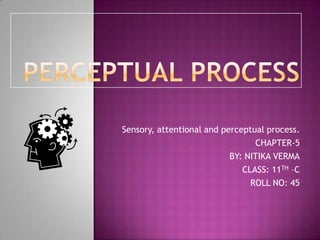
PERCEPTUAL PROCESS
- 1. Sensory, attentional and perceptual process. CHAPTER-5 BY: NITIKA VERMA CLASS: 11TH –C ROLL NO: 45
- 2. The process by which we recognise, interpret, or give meaning to the information provided by sense organs is called PERCEPTION. OR Perception is the organisation, interpretation, and identification of sensory information in order to represent and understand the enviornment.
- 3. 1. The process of receiving stimuli : It is by, •Seeing •Hearing •Smelling •Tasting •Touching
- 4. Top-Down Processing: Information processing guided by higher-level mental processes. As when we construct perceptions drawing on our experience and expectations. Bottom-Up Processing: Analysis that begins with the sense receptors and works up to the brain’s integration of sensory information
- 5. Conclusion: Perception is a complex process by which an individual selectively absorbs or assimilates the stimuli in the environment, cognitively organizes it in a specific fashion and then interprets the information to give a meaning to the environment
- 6. Human beings are not just mechanical and passive recipients of stimuli from the external world. They are CREATIVE BEINGS, and try to understand the external world in their own ways.
- 7. -The needs and desires of a perceiver strongly influence his/her perception. One can fulfil the needs and desire through various ways. -One way is to perceive objects as a picture as something which will satisfy the needs.
- 8. This phenomenon of perceptual familiarisation or perceptual generalisation reflects a strong tendency to see what we expect to see even when the results do not accurately reflect external reality. EXAMPLE: If your milkman delivers your milk daily at 5:30AM , any knocking at the door at that time is likely to be perceived as the presence of the milkman even if it is someone else.
- 9. It refers to a consistent way of dealing with our enviornment. It significantly affects the way we perceive the enviornment. -Most extensivly used in studies is : 1. FIELD INDEPENDENT 2. FIELD DEPENDENT
- 10. Different experiences and learning opportunities available to people in different cultural settings also influence their perception. -People coming from pictureless enviornment fail to recognise objects in pictures.
- 11. • • • Gestalt theory focuses on the mind’s perceptive processes The word "Gestalt" has no direct translation in English, but refers to "a way a thing has been gestellt ; i.e., ‘placed,’ or ‘put together’"; common translations include "form" and "shape"
- 12. • • Gestalt theorists followed the basic principle that the whole is greater than the sum of its parts. In viewing the "whole," a cognitive process takes place – the mind makes a leap from comprehending the parts to realizing the whole.
- 14. 1. 2. 3. 4. 5. 6. 7. The principle of proximity The principle of similarity The principle of continuity The principle of smallness The principle of symmetry The principle of surroundedness The principle of closure
- 15. • The Gestalt law of proximity states that "objects or shapes that are close to one another appear to form groups“ • Even if the shapes, sizes, and objects are radically different, they will appear as a group if they are close together.
- 16. • • • Similarity occurs when objects look similar to one another. People often perceive them as a group or pattern. Our mind groups similar elements to an entity. The similarity depends on form, color, size and brightness of the elements.
- 17. • • Continuation occurs when the eye is compelled to move through one object and continue to another object. "tend to continue shapes beyond their ending points"
- 18. According to this principle, smaller areas tend to be seen as figures against a larger background
- 19. The principle suggest that symmetrical areas tend to be seen as figures against asymmetrical backgrounds
- 20. According to this principle, the areas surrounded by others tend to be perceived as figures.
- 21. • • • Gestalt theory seeks completeness; when shapes aren’t closed, we tend to add the missing elements to complete the image Although the panda is not complete, enough is present for the eye to complete the shape. When the viewer's perception completes a shape, closure occurs.
